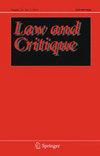Civic Action Against Son Preference in Tirupati, India: Critical International Law Put into Practice?
IF 0.9
Q2 LAW
引用次数: 0
Abstract
Abstract In this paper based on original fieldwork, I seek to contribute to critical scholarship in international law by providing an investigation into the engagement with international law by actors in civil society working against son preference primarily in Tirupati, India. I suggest that the turn to the international legal order by civic actors should be theorized as something else than as merely coming ‘from above’, ‘from below’ or as a ‘translation’ of ‘global’ law to ‘local’ conditions. Instead, I propose that the mobilization of international law within Tirupati’s civil society should be seen as an emancipatory undertaking, an act of resistance with the overarching ambition to reclaim the zenana . In that, I argue, the strategies within Tirupati’s civil society are more appropriately understood as critical international law put into practice.印度蒂鲁帕蒂反对重男轻女的公民行动:关键国际法付诸实践?
在这篇基于原始田野调查的论文中,我试图通过对主要在印度蒂鲁帕蒂反对重男轻女的公民社会行动者参与国际法的调查,为国际法的批判性学术做出贡献。我认为,公民行为者对国际法律秩序的转向应该被理论化,而不仅仅是“来自上面”、“来自下面”或“翻译”“全球”法律到“地方”条件。相反,我建议在蒂鲁帕蒂的公民社会中动员国际法应被视为一项解放的事业,一种具有重新夺回zenana的总体雄心的抵抗行动。在这一点上,我认为,蒂鲁帕蒂的公民社会内部的策略更恰当地被理解为将关键的国际法付诸实践。
本文章由计算机程序翻译,如有差异,请以英文原文为准。
求助全文
约1分钟内获得全文
求助全文
来源期刊

LAW AND CRITIQUE
LAW-
CiteScore
2.30
自引率
25.00%
发文量
19
期刊介绍:
Law and Critique is the prime international critical legal theory journal. It has been published for 20 years and is associated with the Critical Legal Conference. Law and Critique covers all aspects of legal theory, jurisprudence and substantive law that are approached from a critical perspective. Law and Critique has introduced into legal scholarship a variety of schools of thought, such as postmodernism; feminism; queer theory; critical race theory; literary approaches to law; psychoanalysis; law and the humanities; law and aesthetics and post-colonialism. Postmodern jurisprudence, law and aesthetics and law and psychoanalysis were pioneered in Law and Critique which remains the most authoritative international source for these schools of thought. Law and Critique is keen to translate and incorporate non-English critical legal thought. More specifically, Law and Critique encourages the submission of articles in the areas of critical legal theory and history, law and literature, law and psychoanalysis, feminist legal theory, critical race theory, law and post-colonialism; postmodern jurisprudence, law and aesthetics; legal phenomenology; and law and autopoiesis. Past special issues include: ''Critical Legal Education''; ''The Gender of Law''; ''Law and Postmodernism''; ''Law and Literature''; ''Law and Post-colonialism'', ''Law and Theatre''; ''Jean-Luc Nancy and Law''; ''Agamben and Law''. Law and Critique is ranked amongst the top 20 per cent of law journals by the Australian Research Council.
 求助内容:
求助内容: 应助结果提醒方式:
应助结果提醒方式:


